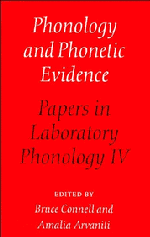Book contents
- Frontmatter
- Contents
- List of contributors
- Acknowledgments
- 1 Introduction
- I Features and Perception
- 2 Intermediate properties in the perception of distinctive feature values
- 3 A double-weak view of trading relations: comments on Kingston and Diehl
- 4 Speech perception and lexical representation: the role of vowel nasalization in Hindi and English
- 5 Processing versus representation: comments on Ohala and Ohala
- 6 On the status of redundant features: the case of backing and rounding in American English
- 7 The perceptual basis of some sound patterns
- II Prosody
- III Articulatory Organization
- Subject index
- Index of names
- Index of languages
2 - Intermediate properties in the perception of distinctive feature values
Published online by Cambridge University Press: 03 May 2011
- Frontmatter
- Contents
- List of contributors
- Acknowledgments
- 1 Introduction
- I Features and Perception
- 2 Intermediate properties in the perception of distinctive feature values
- 3 A double-weak view of trading relations: comments on Kingston and Diehl
- 4 Speech perception and lexical representation: the role of vowel nasalization in Hindi and English
- 5 Processing versus representation: comments on Ohala and Ohala
- 6 On the status of redundant features: the case of backing and rounding in American English
- 7 The perceptual basis of some sound patterns
- II Prosody
- III Articulatory Organization
- Subject index
- Index of names
- Index of languages
Summary
Introduction
Any minimal contrast between speech sounds is conveyed by multiple acoustic differences, in part, because some articulations have more than one acoustic consequence, but also because some minimal contrasts are accomplished by multiple, covarying articulations, each with its own array of acoustic consequences. These facts raise two questions. First, how does the resulting array of acoustic properties get mapped into a specific distinctive feature value when a speech sound is identified by listeners? Second, how are the particular sets of covarying articulations that convey contrasting distinctive feature values selected by speakers?
Two kinds of answers have been offered to the first question. Some covarying acoustic properties may cohere perceptually because they have a common articulatory source, as has been suggested for the consequences of VOT differences by Lisker & Abramson (1970). Alternatively, acoustic properties may cohere because they have similar auditory effects (Diehl & Kluender, 1989; Diehl & Kingston, 1991; Kingston, 1991; Kingston & Diehl, 1994; Kingston & Macmillan, submitted); the experiments reported here explore this second possibility. These experiments also test a possible answer to the second question, that speakers covary articulations precisely because their acoustic consequences are auditorily similar enough to be integrated into more comprehensive perceptual properties, intermediate between the acoustic properties and distinctive feature values.
As Nearey observes in the following commentary, the experiments we report here are thus motivated by a “strong auditorist” perspective, in that we seek to demonstrate strong, i.e., robust and transparent, relations between the listeners’ auditory experience and the symbolic phonological representation of utterances.
- Type
- Chapter
- Information
- Phonology and Phonetic EvidencePapers in Laboratory Phonology IV, pp. 7 - 27Publisher: Cambridge University PressPrint publication year: 1995
- 18
- Cited by



